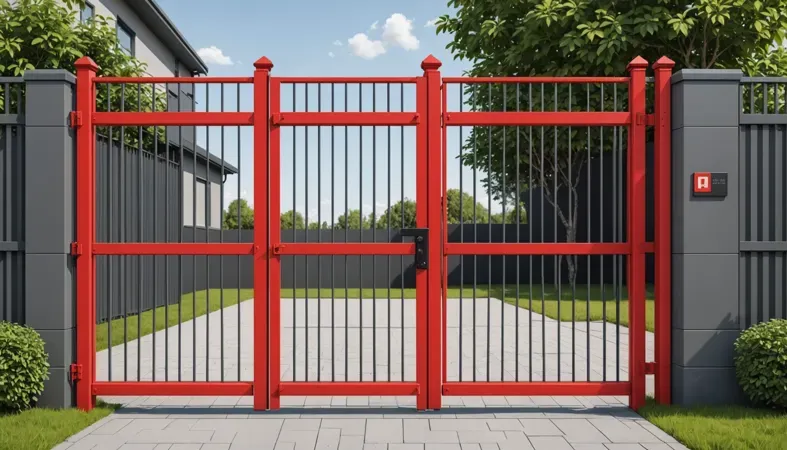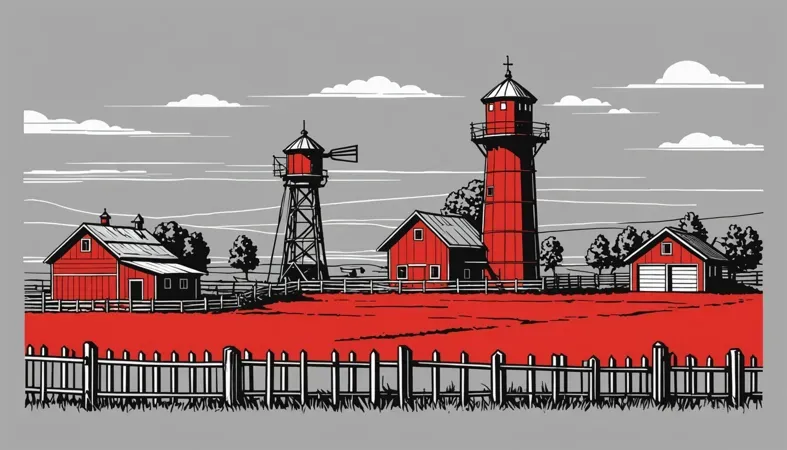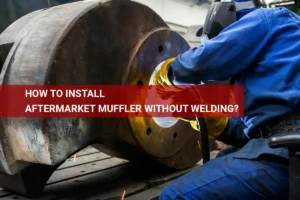How to Weld a Fence Gate? Steps, Safety, Tips, and Troubleshooting
Published on: May 29, 2025 | Last modified: March 4, 2025
By: Tyler James
A fence gate is a movable barrier that allows entry and exit in a fence. It keeps your space secure while providing easy access when needed.
I get asked quite often how to weld a fence gate. Understanding this skill is crucial because it helps you create a sturdy entry point that withstands daily use. In my experience, a well-welded gate reduces maintenance and improves longevity, which can save you time and money.
In this guide, you’ll learn about fence gate types, prerequisites for welding, step-by-step instructions, safety tips, welding methods, factors affecting weld quality, common issues, aftercare, and advanced welding tips. We’ll also cover the benefits of gate welding, its applications, and alternatives like how to make a metal gate without welding.
Contents
- How to Weld A Fence Gate?
- What is a Fence Gate?
- Types Of Fence Gates and Their Weldability
- Prerequisites
- Steps to Weld a Fence Gate
- Safety Tips
- Types Of Welding for Fence Gates
- Factors Affecting Fence Gate Welding
- Common Issues
- Aftercare, Inspection, and Advanced Tips for Fence Gate Welding
- Maintenance and Upkeep of Welded Fence Gates
- Benefits Of Welding a Fence Gate
- Where is Fence Gate Welding Used?
- Are There Any Alternatives to Welding a Fence Gate?
- Frequently Asked Questions (FAQs)
- Wrapping Up
- Additional Reading
How to Weld A Fence Gate?
A fence gate is a movable barrier for accessing enclosed areas. To weld a fence gate, use a MIG welder at about 200 amps (For Mild Steel). The task’s difficulty is moderate, perfect for outdoor gates.
What is a Fence Gate?
A movable barrier that provides access to enclosed areas. It’s typically made from materials like metal, wood, or vinyl. Standard metal fence gates usually measure 1.2 m to 2.4 m (4 Ft to 8 Ft) wide and 1.5 m to 2.1 m (5 Ft to 7 Ft) high. For optimal strength, many use tubular metal frames measuring about 40 mm x 40 mm (1.5 In X 1.5 In) or greater.
When welding a fence gate, it’s more than just connecting parts; proper alignment and fit are crucial. I’ve spent hours ensuring hinges are positioned precisely to avoid misalignment. Crafting a strong, durable fence gate largely depends on weld integrity and stability.
I used it extensively for my backyard renovation. Installing a gate frame was a significant project. I remember figuring out how to weld hinges onto a metal gate. Getting those right made a big difference in functionality. Using quality gate hinges kept my gate swinging smoothly and reinforced the entire structure. Transitioning to welding techniques deepened my appreciation for strong, durable gates.
Types Of Fence Gates and Their Weldability
What types of fence gates can you weld?
Wooden Fence Gates
Wooden fence gates are made from lumber. To attach the wooden frame, use metal brackets or hinges. To weld a wooden gate, use metal support brackets to connect the wood pieces. Fasten the frame with screws, then securely attach the hinges for stability. Ensuring a stable weld requires attention to details such as minimizing factors that cause weld spatter.
Metal Fence Gates
Metal fence gates are strong and durable, often made of steel or aluminum. To create a metal gate, cut the metal to size. Use a MIG welder for clean joints. Grind the edges smooth, then set your pieces and weld each joint. For precise fabrication, understanding how to weld 45-degree angles is essential.
Vinyl Fence Gates
Vinyl fence gates offer low maintenance and a clean look. Welding isn’t common; instead, use screws to secure metal frames inside. Attach the vinyl to a metal frame and secure it with screws to prevent sagging.
Chain Link Fence Gates
Chain link gates consist of metal posts and chain link fabric. Create a frame using tubular steel. Weld the frame together first, then attach the fabric using tension bands and keepers for a firm hold.
Composite Fence Gates
Composite gates combine wood and plastic fibers for durability and a wood-like appearance. They typically don’t weld and rely on aluminum or steel frames. Install the frame, then attach the composite panels with screws or clips for a solid assembly.
You should now have a good understanding of fence gate types and their weldability. In the next part, we’ll discuss prerequisites.

Prerequisites
What do you need to prepare before you start?
- MIG Welder: You’ll need a MIG welder, like the Lincoln Electric Easy MIG 140, to join metal parts effectively.
- Welding Rods: Obtain welding rods, such as Lincoln Electric ER70S-6 (0.030 In/0.8 Mm). They’re essential for strong welds with minimal cleanup.
- Clamps: Get clamps like the Bessey 5500B to hold pieces securely. Good stability ensures accuracy while welding.
- Wire Brush: A wire brush, such as the 3M 2000 Silver Wire Brush, is needed to clean metal by removing rust and contaminants for better weld quality.
- Grinding Wheel: Use a grinding wheel, like the Dewalt DW4904, to smooth edges and correct surface imperfections. This strengthens the weld.
That covers the necessary foundations for the task. Let’s now take a look at the process of welding a fence gate.
Steps to Weld a Fence Gate
Now, we’ll cover the steps to weld a metal gate effectively. Follow them closely for great results.
Prepare the Workspace
Clear the area where you’ll be welding. Ensure it’s free from distractions and fire hazards. A clean workspace boosts safety and quality. Keep your tools nearby and organized in a toolbox or on a table.
Lay down a welding mat or tarp to protect the ground. If you’re working outdoors, choose a day with low wind to minimize the risk of sparks flying.
Set Up Your Welder
Choose the right settings for your welder. For a standard metal gate, set your MIG welder to about 120-140 amps. This range ensures good penetration without burning through thin material.
Connect the ground clamp securely to your workpiece. Double-check all connections. Good grounding is crucial for proper arc stability.
Align the Gate Components
Position the gate frame on your workspace. Ensure it’s square by measuring the diagonal corners. Both diagonals should match within ±1 mm (0.039 In) for a proper fit once the gate is complete.
Use clamps to hold the pieces together during welding. Clamping is vital; it prevents movement, keeping your work precise. Trust me, welding without clamps can lead to mistakes.
Weld the Components Together
Start welding at one corner and travel along the joint seam. Use a stitch welding technique, making short welds spaced apart. Aim for 25-30 mm (1-1.2 In) between each stitch to allow for heat dispersion. Mastering specific techniques can be especially challenging, such as knowing how to weld upside down effectively.
Zigzag your welds at the junctions for added strength. Keep your welder moving; slow speed can lead to burn-through. Maintain a consistent technique for uniform welds.
Weld the Hinges to the Gate
Determine the placement of the hinges, typically 20-30 cm (8-12 in) from the top and bottom. Mark the spots for precision. Weld the hinges on the inside of the frame for a cleaner look when the gate is installed.
Use the same settings as before but ensure good heating on the hinge. Monitor the base metal while welding the hinges to prevent heat distortion. A well-secured hinge is crucial for a durable gate.
Finalize the Gate Structure
Once welded, check each weld for quality. Ensure there are no weak points that could cause future problems. Regrind any excessive spatter for a smooth finish; a clean finish matters.
Consider applying an anti-rust coating or paint if the gate will be exposed to the elements. A good coat protects your work and extends the lifespan of the gate. Prevention is better than repair!
We covered the process of welding a fence gate here. Next, we will cover essential safety guidelines.
Safety Tips
Here are essential precautions for welding a fence gate.
- Wear Protective Gear: Use a welding helmet, gloves, and a leather apron. I always choose Lincoln Protective Gear for maximum protection. Proper gear prevents serious burns and injuries.
- Ventilation: Work in well-ventilated areas or use fans. Proper airflow minimizes harmful gas exposure. A $50 exhaust fan can make a big difference.
- No Flammable Materials: Remove flammable objects from the workspace. Sparks can easily ignite nearby items. Maintain at least 10 feet (3 Meters) of clearance.
- Check for Hazardous Materials: Inspect your work area for gas or chemicals. Improper conditions can lead to fires or explosions. Call a professional if you’re unsure.
Always prioritize safety; it protects you and your hard work.
That covers essential safety precautions for welding. Let’s now take a look at the various types of welding for fence gates.
Types Of Welding for Fence Gates
Let’s move on to the types. We will cover MIG welding, TIG welding, Stick welding, Flux-Cored Arc welding, and Submerged Arc welding.
MIG Welding
MIG (Metal Inert Gas) welding is popular for fence gates. It uses a continuous wire feed as an electrode and a shielding gas. You can quickly create strong joints with a wire feed speed of about 1 to 10 meters per minute (M/min) based on material thickness. This technique is widely utilized in various industries, showcasing its versatility in welding by industry.
Understanding the nuances of welding different materials can enhance your skills; for example, you might explore if you can weld zinc plated steel.
TIG Welding
TIG (Tungsten Inert Gas) welding offers precision, making it ideal for gates requiring clean finishes. It uses a non-consumable tungsten electrode and often a filler rod. Though it may take longer, around 20 inches per minute (In/min) on thin materials, it yields exceptional results.
Stick Welding
Stick welding, or Shielded Metal Arc Welding (SMAW), is simple and effective. An electrode melts to form a weld puddle. With welding rods ranging from 1/16 to 3/16 inches (1.59 To 4.76 Mm), it’s great for sturdy fence gates in rugged conditions.
Flux-cored Arc Welding
Flux-Cored Arc Welding (FCAW) is similar to MIG but uses a tubular wire filled with flux. It’s accessible and suitable for outdoor work since it doesn’t require external shielding gas. You’ll achieve welds up to 1/4 inch (6.35 Mm) thick quickly, which is ideal for busy projects.
Submerged Arc Welding
Submerged Arc Welding (SAW) conceals the arc under a layer of granulated flux. This minimizes splash and reduces weld spatter. Preferred for heavy-duty applications, it can weld layers up to 1 inch (25.4 Mm) thick, providing significant strength to a fence gate. For those interested in mastering different techniques, exploring the specifics of seam welding can also be beneficial for understanding various welding processes.
Factors Affecting Fence Gate Welding
What factors influence the process of connecting metal for a sturdy gate?
Material Thickness
Material thickness significantly affects penetration depth during welding. For example, 1/4 inch (6 Mm) steel requires different settings than 1/2 inch (12 Mm) steel, impacting your gate’s final strength.
Welding Technique Used
Different welding techniques, like MIG or TIG, yield varying results. MIG is faster and great for beginners, while TIG offers precision for thinner materials in detailed gate sections.
Heat Settings on Welder
Heat settings must match the material type and thickness. I recommend starting with a 20-25 volt setting for 1/4 inch steel to avoid burn-through and ensure a strong weld.
Environmental Conditions
Welding in windy or wet conditions can compromise weld integrity. Ideally, aim for a temperature between 50°F and 85°F (10°C to 29°C), as lower temperatures can cause brittleness in the weld.
Type Of Welding Rod
The welding rod type is crucial. For welding iron gates, an E7018 rod is advisable due to its strength and low hydrogen content, which helps prevent cracking.
Common Issues
Let’s look at specific problems with the fence gate.
Warping Of the Gate
Fence gates can warp due to temperature changes. You can identify warping by looking for uneven gaps. To fix this, heat the gate slightly and apply weight until it cools.
Inconsistent Weld Beads
The fence gate may have inconsistent weld beads, which weakens it. Look for uneven weld lines. I recommend adjusting your welder settings for a consistent temperature.
Overheating Of Materials
If the fence gate overheats, it can lose strength. Check for color changes. Use cooled areas to inform you to reduce your welding time temporarily.
Improper Fit-up
An improper fit-up can cause gate misalignment during installation. Look for gaps when assembling. Adjust joints before welding to ensure a snug fit.
Corrosion Over Time
Fence gates can corrode, especially when exposed to moisture. Check for rust spots. To prevent this, apply a rust-inhibiting primer before painting.
Aftercare, Inspection, and Advanced Tips for Fence Gate Welding
Here’s key info to help you maintain your newly welded fence gate.
Aftercare Strategies
After you create your fence gate, clean the welds with a wire brush to remove slag. Coat the welds with rust-preventive paint for durability up to 5 years. Monitor your gate’s alignment regularly; a misaligned gate can cause wear. Minor adjustments usually fix alignment shifts.
Inspection Elements
Inspect hinges every six months, focusing on signs of wear or looseness. Use a torque wrench to check hinge bolts; they should be within 12-15 Nm (8-11 Lb-ft). Ensure the gap between the gate and posts is no more than 5 mm (0.2 In) for smooth function. I’ve had great results with products like Loctite threadlocker for securing bolts.
Expert Tips
From one expert to another, consider adding reinforcement braces at the gate’s center for extra stability. Choose a wall thickness of 2.5 mm (0.1 In) for maximum strength when welding supports. Apply protective coatings on a calm day to prevent overspray; aim for 20-25 °C (68-77 °F) for optimal drying times, which enhances longevity.
Maintenance and Upkeep of Welded Fence Gates
Proper maintenance ensures your welded fence gate remains functional and looks great. Here are some key strategies.
Regular Cleaning
- Clean Welded Areas: Use a wire brush or sandpaper to remove debris, rust, and paint. This helps maintain a clean welding surface and enhances the gate’s aesthetics.
- Wash the Gate: Clean the entire gate with soap and water at least every six months. A thorough wash prevents corrosion and keeps the gate looking fresh.
Inspection Schedule
Regular inspections help catch problems early. Here’s what to look for:
- Check for Rust: Inspect for signs of rust and treat immediately. Use a rust-inhibiting primer to protect the metal and extend its lifespan.
- Examine Hinges: Ensure hinges are tight and functioning smoothly. Loose hinges can lead to misalignment. Tighten them with a torque wrench set to 12-15 Nm (8-11 Lb-ft).
- Look for Corrosion: Inspect weld points and metal surfaces. Address any corrosion with grinding and repainting to prevent further damage.
Replacement of Damaged Parts
| Component | Signs of Damage | Maintenance Action |
|---|---|---|
| Hinges | Worn or rusty | Replace with new, lubricate regularly |
| Lock | Stiff or rusty | Replace, use graphite lubricant |
| Frame | Visible bends or cracks | Reinforce or replace sections |
Painting and Coating
Applying paint or a protective coating every few years can significantly enhance durability. Choose weather-resistant paint designed for metal. This not only protects against rust but also adds to your gate’s aesthetic appeal. I recommend a touch-up every 2-3 years for the best protection against the elements.
Benefits Of Welding a Fence Gate
The main advantage of welding a fence gate is its strength. I use it frequently to keep my property secure and ensure durability.
Additionally, welding provides a seamless finish, enhances aesthetic appeal, and offers customization options. Plus, it’s often quicker than other methods, so you can enjoy your gate sooner. You also gain corrosion resistance, meaning your gate lasts longer.
Where is Fence Gate Welding Used?
I’ve seen people use fence gate welding to secure property, but it has many applications, including:
- Custom Fabrication: Welded gates are ideal for custom designs. Builders often need unique sizes or styles to match properties, making these gates popular in residential and commercial projects.
- Community Security: Well-designed welded gates improve safety for parks and community areas. Quality welding deters unauthorized entry, prompting property managers to prioritize this solution.
- Animal Enclosures: Farmers often weld gates for livestock pens. These durable gates ensure animals’ safety while withstanding daily impacts.
- Automated Entry Systems: Many businesses install welded gates with automatic mechanisms. This integration enhances security and convenience in high-traffic situations.

Are There Any Alternatives to Welding a Fence Gate?
Sure thing! If welding’s not your gig, you can always use steel brackets or heavy-duty rivets. Products like the Mighty Pouch® Steel Fastening System can securely attach the gate without the fuss of welding. Over time, I’ve observed that these options work great for DIYers or those lacking welding skills.
Another option is using threaded bolts and nuts, which are both affordable and simple to use. Brands like Hillman provide a variety of sizes to fit your fence gate project. Ideally, you’d go for alternatives when precision isn’t a strict requirement, allowing for an easy and effective solution.
Frequently Asked Questions (FAQs)
Now let us look at some common questions I typically get asked about welding gates.
What Welder is Used for Gates?
For welding gates, a MIG welder is commonly used. MIG welding is preferred due to its efficiency and versatility in working with various metal types. It operates at a voltage range of 18-26 volts, making it suitable for both thin and thicker metals.
How Do You Reinforce a Fence Gate?
To reinforce a fence gate, use diagonal bracing and quality hinges. Adding a diagonal brace helps distribute weight evenly, providing better stability and preventing sagging. This way, you can extend the gate’s lifespan and enhance its functionality.
How to Fix a Metal Gate That Has Dropped?
To fix a dropped metal gate, check and adjust the hinges first. If they’re loose or damaged, repair or replace them immediately. Additionally, adding a support bracket can help ensure the gate remains level and opens smoothly.
How to Secure a Fence Gate?
To secure a fence gate, install high-quality locks or latches. A good lock prevents unauthorized access and provides peace of mind. Consider using locks made from hardened steel for better durability, which can withstand attempts at forced entry.
How to Weld Hinges on a Metal Gate?
To weld hinges on a metal gate, position the hinge on the gate frame and use a MIG or TIG welder for a strong bond. Ensure that you’re using an appropriate electrode and set your welder to match the thickness of the metal. This guarantees a solid connection that lasts.
Wrapping Up
You made it to the end. We covered what a fence gate is, the various types of fence gates and their weldability, safety tips, prerequisites, and steps to weld a fence gate. Also discussed were types of welding, common issues, aftercare, inspection, factors affecting the welding process, benefits of welding a fence gate, and alternatives to welding.
So, how to weld a fence gate? Simply choose your gate type, then cut and prepare the metal, and use the right welding techniques like MIG or TIG. Keep safety in mind, and check for common issues during your project. Wishing you success in your welding endeavors, and remember: the right prep makes all the difference.
If you’re eager to enhance your welding skills further, don’t hesitate to check out What is Welding for additional insights and resources.
Additional Reading
- ISO. (2017). ISO 3834: Quality Requirements for Fusion Welding of Metallic Materials. Geneva, Switzerland: ISO.
- American Welding Society. (2018). AWS D14.3: Specification for Welding Earthmoving and Construction Equipment. Miami, FL: AWS.
- Miller Electric. (2021). Welding Safety: A Complete Guide. Appleton, WI: Miller Electric Manufacturing Company.
Tyler is a passionate DIY welder and self-taught metal artist with years of hands-on experience transforming raw materials into functional and artistic creations. Specializing in MIG welding, Tyler crafts everything from custom furniture to outdoor sculptures, blending creativity with technical skill. Committed to making welding accessible, Tyler shares practical insights and project inspiration to help beginners and hobbyists confidently explore the world of metalworking.
American Welding Society, DIY Projects, Fence Gates, Metalworking, MIG Welding, Safety Tips, Welding, Welding Techniques







